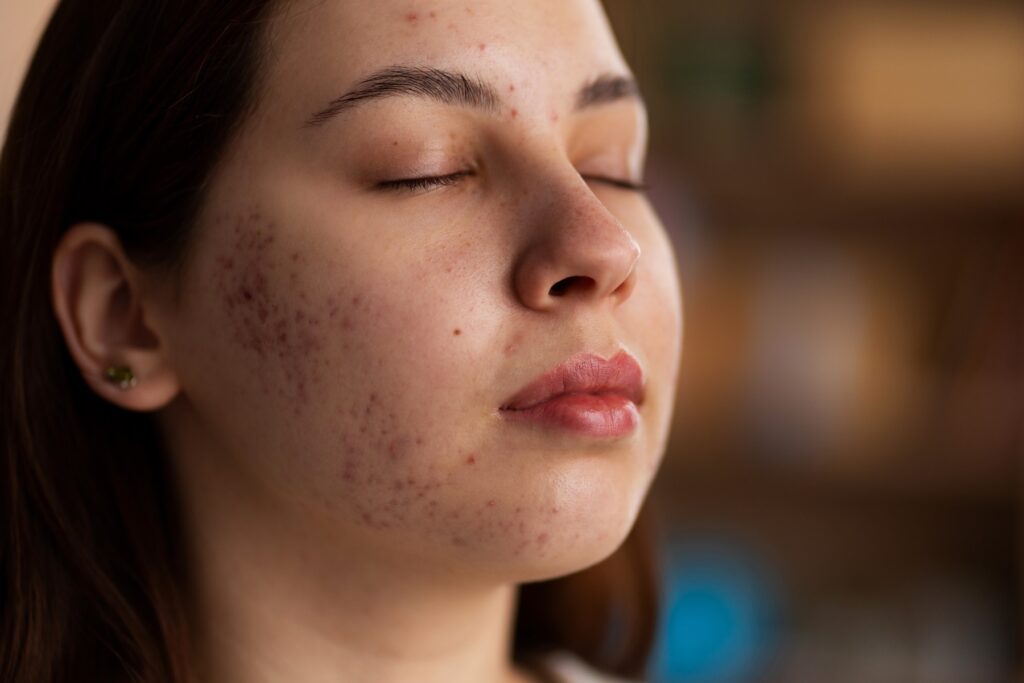- 70855-06939
- drponamrathod025@gmail.com
- Sandeep Vihar Society ,GH 79, Sect 20, Panchkula

Acne & Acne Scar
Acne is one of the most common skin conditions, affecting millions of people worldwide, particularly during adolescence. It is a condition where hair follicles become clogged with oil, dead skin cells, and bacteria, leading to inflammation and the formation of pimples, blackheads, whiteheads, nodules, or cysts. While it primarily appears on the face, acne can also affect other areas like the back, chest, and shoulders.
Causes of Acne
The development of acne is primarily linked to the overproduction of sebum, a natural oil produced by sebaceous glands. Hormonal changes, especially during puberty, menstruation, pregnancy, or due to conditions like polycystic ovary syndrome (PCOS), can trigger excessive sebum production.
Acne is not merely a cosmetic issue—it can significantly impact mental health, leading to anxiety, low self-esteem, and even depression in severe cases. Therefore, seeking timely treatment is crucial.
Types of Acne Scars
For many individuals, acne doesn’t just stop at the initial outbreak. Even after the acne subsides, it can leave behind scars, which are often more challenging to manage than acne itself. Acne scars are caused by the skin’s healing process and can vary in appearance. The most common types include:
- Atrophic Scars:
These are depressed scars caused by the loss of skin tissue. They are further categorized as:- Ice Pick Scars: Narrow, deep scars that resemble small punctures.
- Boxcar Scars: Broad, shallow depressions with well-defined edges.
- Rolling Scars: Wavy, uneven scars caused by tethering of the skin to underlying structures.
- Hypertrophic Scars:
These are raised scars caused by an overproduction of collagen during the healing process. They are more common on the back and chest than on the face. - Post-Inflammatory Hyperpigmentation (PIH):
While not a true scar, PIH manifests as dark spots left behind after acne heals, particularly in individuals with darker skin tones.
Treatments for Acne and Acne Scars
The treatment of acne and its scars depends on the severity of the condition. For active acne, options include topical treatments such as benzoyl peroxide, salicylic acid, and retinoids, as well as oral medications like antibiotics or isotretinoin for more severe cases. Acne scars, however, often require more intensive interventions. Treatments include:
- Chemical Peels: Help exfoliate the skin and reduce mild scarring.
- Microneedling: Stimulates collagen production, improving the appearance of scars.
- Laser Therapy: Targets scarred tissue and promotes new skin growth.
- Dermal Fillers: Fill depressed scars for a smoother skin surface.
- Subcision: Releases scar tissue tethered to the skin.
Emerging Treatments for Acne Scars
Modern dermatology continues to evolve, offering innovative solutions for acne scars:
- Fractional CO2 Laser: An advanced form of laser treatment that targets deep scars while preserving healthy skin.
- Platelet-Rich Plasma (PRP) Therapy: Uses the patient’s blood components to promote skin healing and rejuvenation.
- Stem Cell Therapy: A cutting-edge approach aimed at regenerating damaged skin tissue.
- Combination Treatments: Many dermatologists now recommend a mix of treatments, such as microneedling with PRP or laser therapy with subcision.
Menu
